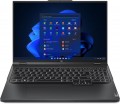Refresh rate
The frame rate supported by the laptop screen. In fact, in this case we are talking about the maximum frequency; the actual frame rate may be lower than this value, depending on the content being displayed — but not higher.
Theoretically, the higher the frame rate, the smoother the movement on the screen will look, the less moving objects will be blurred. In fact, the situation is such that even in relatively modest modern laptops,
60 Hz matrices are installed — in general, this is quite enough for the human eye, since a further increase in speed (
90 Hz and higher) does not significantly improve the visible “picture”. However, in high-end gaming and multimedia models designed for demanding users, higher values —
120 Hz,
144 Hz,
165 Hz and even
higher, namely
240 Hz and
300 Hz.
Brightness
The maximum brightness that a laptop screen can provide.
The brighter the ambient light, the brighter the laptop screen should be, otherwise the image on it may be difficult to read. And vice versa: in dim ambient light, high brightness is unnecessary — it greatly burdens the eyes (however, in this case, modern laptops provide brightness control). Thus, the higher this indicator, the more versatile the screen is, the wider the range of conditions in which it can be effectively used. The downside of these benefits is an increase in price and energy consumption.
As for specific values, many modern laptops have a brightness of
250 – 300 cd / m2 and even
lower. This is quite enough for working under artificial lighting of medium intensity, but in bright natural light, visibility may already be a problem. For use in sunny weather (especially outdoors), it is desirable to have a brightness margin of at least
300 – 350 cd / m2. And in the most advanced models, this parameter can be
350 – 400 cd / m2 and even
more.
VESA DisplayHDR Certification
VESA DisplayHDR certified, which corresponds to a screen that supports HDR technology.
See above for more details on this technology. And VESA DisplayHDR is an open standard that defines the overall image quality on an HDR screen by a number of parameters — brightness, colour depth, etc. Based on the test results, a screen that meets the required parameters is assigned a certain certificate with a numerical designation. So, the minimum level is DisplayHDR 400, the maximum is DisplayHDR 1400 (although in laptops, as of the end of 2020, there are no screens higher than DisplayHDR 1000). The number in such a designation is indicated by the brightness that the screen must provide: for example, DisplayHDR 400 must produce at least 400 cd / m2. Accordingly, a higher number denotes more extensive display capabilities and more advanced HDR performance.
A separate case is the DisplayHDR True Black certifications. This standard was specifically created for so-called emissive displays such as OLED (see "Matrix type"), which are capable of displaying very deep blacks. The native brightness of such displays is not very high — in particular, the current DisplayHDR 400 True Black and DisplayHDR 500 True Black provide a total screen brightness of only 250 and 300 cd / m2, respectively (against 400 and 500 cd / m2 in the original standards, without the addition " True Black"). However, in terms of black transmission efficiency, such di
...splays surpass conventional HDR counterparts by orders of magnitude, which gives a noticeable increase in image quality — in particular, the mentioned True Black standards with indexes 400 and 500 win even when compared with conventional DisplayHDR 1000. However, it should be taken into account that that this advantage is most noticeable in relatively dim ambient light. Model
The specific model of the processor installed in the laptop, or rather, the processor index within its series (see above). Knowing the full name of the processor (series and model), you can find detailed information on it (up to practical reviews) and clarify its capabilities.
Processor cores
The number of cores in the laptop CPU.
The core is a part of the CPU designed to process one thread of instructions (and sometimes more, for such models, see "Number of threads"). Nowadays, in laptops you can find
dual-core,
quad-core,
six-core,
eight-core,
ten-core,
12-core,
14-core CPUs. Also note that recently configurations with different types of cores as part of a single CPU are gaining popularity. Such chips are built on a hybrid architecture that combines high performance and energy-efficient cores. They operate at different clock speeds, have different amounts of pre-installed cache memory and are designed to solve different problems. In particular, such CPUs are found in Intel CPUs (from the 12th generation) and Apple.
Theoretically, more cores means higher performance, especially in parallel computing tasks or when processing multiple resource-intensive tasks at the same time. However, in practice this is true only all else being equal – that is, with a similar microarchitecture, clock frequency, cache volumes and other key parameters. Modern CPUs can vary greatly on these parameters – in itself, a greater number of cores does not mean superiority. This is especially true for dual- and quad-core chips: a mobil
...e-level CPU (for example, Snapdragon, see "CPU series") with 4 cores may well be inferior in capabilities to a dual-core desktop series chip (like Core i3 or i5, which are often used in universal laptops with the "optimal" set of specifications for different tasks). When evaluating CPUs with two or four cores, it is necessary to look, first of all, at the general set of characteristics. But the presence of six, eight or more cores is almost certainly a sign of a powerful CPU. Such equipment is typical mainly for advanced gaming and professional laptops.Total threads
The number of threads supported by the laptop processor.
A thread is a sequence of instructions executed by a processor. Initially, each processor core was designed for one such sequence, and the number of threads was equal to the number of cores. However, in modern CPUs, multithreading technologies are increasingly being used, which allow loading each core with two instruction sequences at once. Such technologies have different names for different manufacturers, but the principle of their operation is the same: during the inevitable pauses in the execution of one of the threads, the kernel does not idle, but works with a different sequence. Accordingly, the total number of threads in such processors is twice the number of cores; such a scheme of work significantly increases productivity (although, of course, it also affects the cost).
CPU speed
The clock speed of the processor installed in the laptop (for multi-core processors, the frequency of each individual core).
Theoretically, a higher clock speed has a positive effect on performance, as it allows the processor to perform more operations per unit of time. However, in fact, the capabilities of the CPU depend on a number of other characteristics — primarily on the series to which it belongs (see above). It even happens that of the two chips, the more performant in the overall result is the slower one. With this in mind, it makes sense to compare by clock frequency only processors of the same series, and ideally, also of the same generation; and the laptop as a whole should be judged by the complex characteristics of the system, as well as by the results of tests (see below).
CPU TDP
The amount of heat generated by the processor during normal operation. This parameter determines the requirements for the cooling system necessary for the normal operation of the processor, therefore it is sometimes called TDP - thermal design power, literally “thermal (cooling) system power”. Simply put, if the processor has a heat dissipation of 60 W, it needs a cooling system that can remove at least this amount of heat. Accordingly, the lower the TDP, the lower the requirements for the cooling system.
3DMark06
The result shown by the laptop processor in 3DMark06.
This test is primarily focused on testing performance in games — in particular, the ability of the processor to process advanced graphics and artificial intelligence elements. Test scores are reported as scores; the higher this number, the higher the performance of the tested chip. Good 3DMark06 results are especially important for
gaming laptops.

